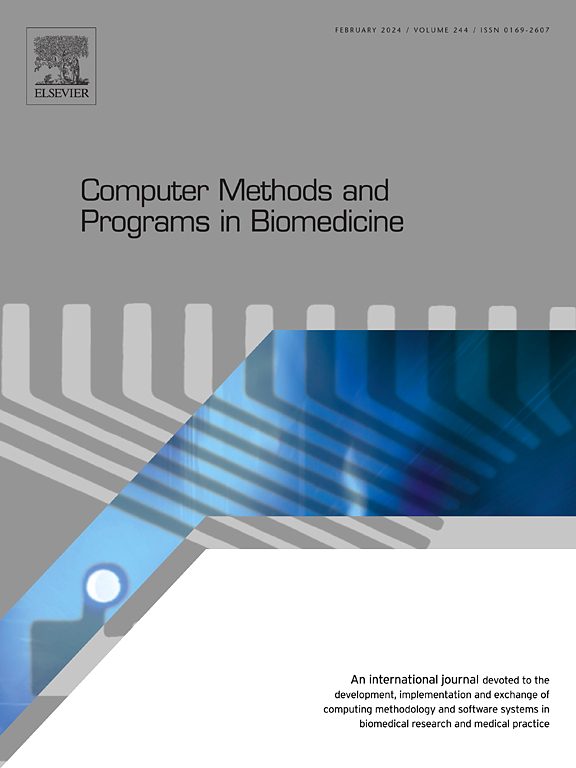From clinical measurements to articulated foetus: Statistical shape modeling of bone contours using PLSR for enhanced childbirth simulation
IF 4.8
2区 医学
Q1 COMPUTER SCIENCE, INTERDISCIPLINARY APPLICATIONS
引用次数: 0
Abstract
Background and objective
The prediction of childbirth-related complications requires realistic patient-specific childbirth simulations with articulated foetal bodies. However, the foetal models used in current simulations are oversimplified and generally based on scaled generic models. This study presents the development and evaluation of a full-body (hands and feet excluded) foetal statistical shape model (SSM) based on CT scans to generate fast and accurate foetal geometries and lower the simulation errors due to linear scaling.
Methods
The developed SSM was based on a dataset of 96 subjects under one year of age. All scans were segmented and articulated to put the subjects in a similar posture. Then, the bone contours were extracted using an alpha-shape algorithm to decrease the model’s complexity. Bones were individually fitted to a template mesh to obtain point correspondences, and a PCA was conducted on the concatenated skeletons to capture the morphological variations between subjects. A PLSR was trained to allow skeletal geometry prediction using a set of anthropometrical data and bone measurements.
Results
Our shape model predicted the bone geometry with a root mean square error (RMSE) of 2.10 ± 1.42 mm for the head-only model and with an RMSE = 6.69 ± 3.85 mm for the full-body model. For all models, the SSM performed better at predicting the bone geometries than the mean shape obtained by PCA, considered as a baseline.
Conclusions
The present study proposed a first complete foetal SSM, allowing a fast and accurate prediction of the bone geometries using a reduced set of easily accessible predictors. This opens new avenues in the realistic childbirth modeling with articulated foetus for predicting physiological delivery and associated complication scenarios.

从临床测量到关节胎儿:使用PLSR增强分娩模拟的骨轮廓统计形状建模
背景与目的预测分娩相关并发症需要现实的患者特异性分娩模拟与关节胎儿的身体。然而,目前在模拟中使用的胎儿模型过于简化,并且通常基于缩放的通用模型。本研究提出了一种基于CT扫描的全身(不包括手和脚)胎儿统计形状模型(SSM)的开发和评估,以生成快速准确的胎儿几何形状,并降低由于线性缩放引起的模拟误差。方法开发的SSM基于96名1岁以下被试的数据集。所有的扫描都被分割和连接,以使受试者处于相似的姿势。然后,使用alpha-shape算法提取骨骼轮廓,以降低模型的复杂度。将骨骼单独拟合到模板网格中以获得点对应关系,并对连接的骨骼进行主成分分析以捕获受试者之间的形态学变化。PLSR经过训练,可以使用一组人体测量数据和骨骼测量来预测骨骼几何形状。结果仅头部模型预测骨几何形状的均方根误差(RMSE)为2.10±1.42 mm,全身模型的均方根误差(RMSE)为6.69±3.85 mm。对于所有模型,SSM在预测骨骼几何形状方面比PCA获得的平均形状表现更好,被认为是基线。本研究提出了第一个完整的胎儿SSM,使用一组简化的易于获取的预测因子,可以快速准确地预测骨骼几何形状。这开辟了新的途径,在现实分娩建模与铰接胎儿预测生理分娩和相关并发症的情况。
本文章由计算机程序翻译,如有差异,请以英文原文为准。
求助全文
约1分钟内获得全文
求助全文
来源期刊

Computer methods and programs in biomedicine
工程技术-工程:生物医学
CiteScore
12.30
自引率
6.60%
发文量
601
审稿时长
135 days
期刊介绍:
To encourage the development of formal computing methods, and their application in biomedical research and medical practice, by illustration of fundamental principles in biomedical informatics research; to stimulate basic research into application software design; to report the state of research of biomedical information processing projects; to report new computer methodologies applied in biomedical areas; the eventual distribution of demonstrable software to avoid duplication of effort; to provide a forum for discussion and improvement of existing software; to optimize contact between national organizations and regional user groups by promoting an international exchange of information on formal methods, standards and software in biomedicine.
Computer Methods and Programs in Biomedicine covers computing methodology and software systems derived from computing science for implementation in all aspects of biomedical research and medical practice. It is designed to serve: biochemists; biologists; geneticists; immunologists; neuroscientists; pharmacologists; toxicologists; clinicians; epidemiologists; psychiatrists; psychologists; cardiologists; chemists; (radio)physicists; computer scientists; programmers and systems analysts; biomedical, clinical, electrical and other engineers; teachers of medical informatics and users of educational software.
 求助内容:
求助内容: 应助结果提醒方式:
应助结果提醒方式:


